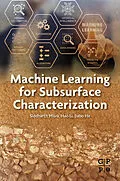- Learn from 13 practical case studies using field, laboratory, and simulation data
- Become knowledgeable with data science and analytics terminology relevant to subsurface characterization
- Learn frameworks, concepts, and methods important for the engineer's and geoscientist's toolbox needed to support
Siddharth Misra is currently associate professor at the Harold Vance Department of Petroleum Engineering, Texas A&M University, College Station, Texas. His research work is in the area of data-driven predictive models, machine learning, geosensors, and subsurface characterization. He earned a PhD in petroleum engineering from the University of Texas and a bachelor of technology in electrical engineering from the Indian Institute of Technology in Bombay. He received the Department of Energy Early Career Award in 2018 to promote geoscience research.
Autorentext
Siddharth Misra is currently associate professor at the Harold Vance Department of Petroleum Engineering, Texas A&M University, College Station, Texas. His research work is in the area of data-driven predictive models, machine learning, geosensors, and subsurface characterization. He earned a PhD in petroleum engineering from the University of Texas and a bachelor of technology in electrical engineering from the Indian Institute of Technology in Bombay. He received the Department of Energy Early Career Award in 2018 to promote geoscience research.
Inhalt
1. Unsupervised outlier detection techniques for well logs and geophysical data 2. Unsupervised clustering methods for noninvasive characterization of fracture-induced geomechanical alterations 3. Shallow neural networks and classification methods for approximating the subsurface in situ fluid-filled pore size distribution 4. Stacked neural network architecture to model themultifrequency conductivity/permittivity responses of subsurface shale formations 5. Robust geomechanical characterization by analyzing the performance of shallow-learning regression methods using unsupervised clustering methods 6. Index construction, dimensionality reduction, and clustering techniques for the identification of flow units in shale formations suitable for enhanced oil recovery using light-hydrocarbon injection 7. Deep neural network architectures to approximate the fluid-filled pore size distributions of subsurface geological formations 8. Comparative study of shallow and deep machine learning models for synthesizing in situ NMR T2 distributions 9. Noninvasive fracture characterization based on the classification of sonic wave travel times 10. Machine learning assisted segmentation of scanning electron microscopy images of organic-rich shales with feature extraction and feature ranking 11. Generalization of machine learning assisted segmentation of scanning electron microscopy images of organic-rich shales 12. Characterization of subsurface hydrocarbon/water saturation by processing subsurface electromagnetic logs using a modified Levenberg-Marquardt algorithm 13. Characterization of subsurface hydrocarbon/water saturation using Markov-chain Monte Carlo stochastic inversion of broadband electromagnetic logs
